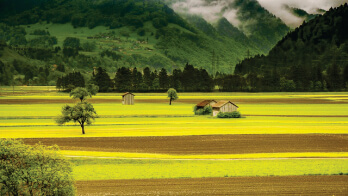Are those unsightly patches on your walls or garden giving you a headache? Before you grab that cleaning solution, it’s time to clear up the confusion between moss vs mold. While they may appear similar at first glance, these two organisms couldn’t be more different! In this comprehensive blog post, we’ll dive deep into their unique characteristics and shed light on the key differences between moss and mold.
So, whether you’re a homeowner battling with unwanted growth or simply curious about the fascinating world of fungi – get ready to unravel the mysteries as we embark on an enlightening journey of understanding moss versus mold!
Moss Vs Mold (Comparison Table)
| Moss | Mold |
|---|---|
| Moss is a non-flowering plant that forms clumps or mats. It lacks branches, leaves, and roots, typically found in damp locations on rocks, logs, and trees. | Mold is a type of fungus occurring indoors and outdoors. It develops in damp spots like bathrooms, basements, etc. |
| Moss grows in small clusters or mats, featuring thin stems. Its color ranges from green to yellowish-green. | Mold appears as fuzzy patches, with spots in black, grey, or white tones. |
| It thrives in moist, shady areas and humid climates. | It flourishes in dark, damp environments such as bathrooms and basements, where moisture accumulates. |
| It belongs to the division Bryophyta. | It falls under the Kingdom Fungi. |
| Moss is typically green but can also appear yellowish-green. | Mold appears black, grey, or white depending on its species. |
| It helps retain moisture in the soil. | It can cause structural damage to buildings and contribute to health problems like allergies and asthma. |
| Moss reproduces through spores. | Mold reproduces by generating microscopic airborne spores called conidia. |
What is Moss?

Moss is a non-vascular plant, commonly referred to as a “bryophyte”. It is known for its ability to grow in areas of high moisture and low light. Moss is typically found in moist, shady areas such as forests and meadows. Moss has been used for centuries for a variety of uses including fuel, insulation, dye, and medicinal purposes.
What is Mold?

Mold is a type of fungi that grows in moist environments. Mold can be found in a variety of colors, including black, white, green, and brown. Mold releases spores into the air, which can cause allergic reactions in some people. Moreover, prolonged exposure to mold can cause respiratory illnesses.
Key Differences between Moss and Mold
- Meaning: Moss is a type of non-flowering plant that grows in clumps or mats in moist and damp locations. It has no branches, leaves, or roots, and is typically found growing on rocks, logs, and tree bark. Mold is a type of fungus that can be found both indoors and outdoors. It forms in damp places such as bathrooms, kitchens and basements.
- Appearance: Moss typically grows in small clumps or mats with thin stems extending from it that range from green to yellowish-green in color. Mold appears as fuzzy patches of small black, grey, or white spots which can sometimes be slimy or wet to the touch.
- Impact on the Environment: Moss helps retain moisture in soil while mold can cause structural damage to buildings and can contribute to health problems such as allergies and asthma.
- Reproduction: Moss reproduces through spores while mold reproduces through the formation of microscopic airborne spores called conidia.
Health Concerns of Moss and Mold
So, what are the key health concerns associated with moss and mold?
Moss is not known to cause any health concerns in humans or animals. In fact, many people find moss to be aesthetically pleasing and use it as ground cover in their gardens.
However, mold can pose serious health risks to humans and animals. Some mold species produce toxins (mycotoxins) that can cause serious illness or death if ingested. Inhaling mold spores can also cause respiratory problems such as asthma attacks or allergic reactions.
If you suspect you have a mold problem in your home or office, it’s important to have it professionally remediated as soon as possible.
How to Clean and Prevent Moss and Mold
Now that you know the difference between moss and mold, here’s how to clean and prevent them:
– To clean moss or mold from a surface, scrub it with soapy water and a brush. You can also use a diluted bleach solution (1 part bleach to 10 parts water). Be sure to rinse the area afterward with clean water.
– To prevent moss and mold from growing in your home, keep indoor humidity levels low (between 30 % and 50%) and make sure your home is properly ventilated.
– If you find any moss or mold in your home, remove it immediately. Also, inspect the area for any water damage or leaks that could be causing the problem. Fix these issues right away to help prevent future growth.
Conclusion
As we have seen, there are many differences between moss and mold. While both types of organisms may look similar to the untrained eye, they are actually quite different in terms of their biology, ecology, and potential uses.
Whether you’re an amateur naturalist or a professional scientist trying to identify these two organisms out in the field, it’s important to take into account all of the key distinctions that make each one unique. By understanding what sets them apart from each other, you can ensure accurate identification when dealing with either type of organism.
FAQs
Does mold grow on moss?
Yes, mold can grow on moss if the environment is damp and has a suitable temperature. The moisture in the air and other nutrients allow for the growth of molds on moss.
Is moss a fungus?
No, moss is not a fungus. Moss is an independent plant form and kingdom that contains many species of non-vascular plants. Fungi are in a different kingdom altogether and have distinct features and characteristics from moss.
Is moss a plant or a bacteria?
Moss is a plant. Moss belongs to the division Bryophyta and is part of the kingdom Plantae. It is not a bacteria, which belongs to the domain Bacteria.



